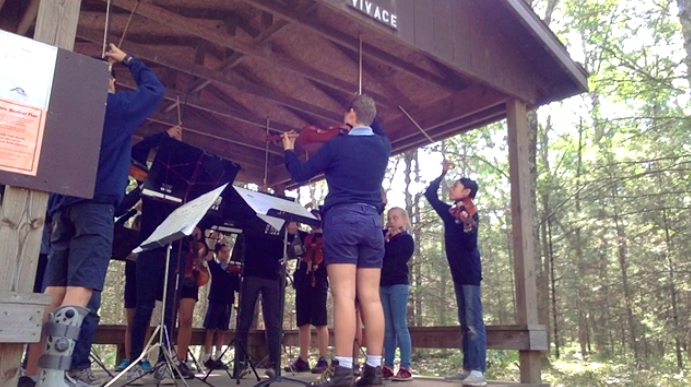
Another role that I served at Blue Lake Fine Arts Camp was teaching the Camp Bernstein violin sectionals.
The students in Camp Bernstein were the youngest on the camp — ranging from incoming 5th graders to 8th graders. Some of them were in their first year with a band or orchestra instrument. Others had been playing violin or cello since they were four years old with the Suzuki method. Most, however, had only been playing in an orchestra for one or two years, and few had ever participated in sectionals.
I had the fortune to teach violin sectionals with two other fantastic violinists. One, Elma Sanabria, is finishing up her graduate degree at the University of Alabama and has started the audition process for a DMA program. She is a fantastic player, but also has a wonderful ability to work almost as a teammate with students. They trust that she is on their side and serving their interests, and will therefore follow her advice. The other teacher was Kaitlyn Fulch, who is completing her violin performance degree at Marshall University in West Virginia. She has less experience teaching violin, but I appreciated how she took on important teaching responsibilities and pushed herself to try teaching techniques and situations that were at first uncomfortable. She really inspired me in the way she grew as a teacher over our two months at Blue Lake.
Each session we had about 30 violin students and just 11 days total to work with them.
The orchestra director would start with folders full of 10-15 pieces, and by the final Sunday they would have narrowed down the selection to 5 or 6 to be performed. Our goal as their section teachers was to make sure each violinist was as confident as possible on the music. That meant correcting posture, developing their sound quality, checking for comprehension of the sheet music itself, introducing common orchestra practices (always have a pencil!), and cultivating ensemble skills.
We would generally split the class up into first violin and second violin groups, with one teacher for each. One of us would float back and forth between the first and seconds to make corrections, play along, or pull out a group of violinists who needed extra help.
I taught the sectional out in a hut in the middle of the forrest. Surrounded by trees, birds, and mosquitos we would set up our stands, practice the orchestra music together, and improve as violinists.

By doing this process four times in the course of two months, teaching a violin sectional nearly every day, I feel like I really improved the way I teach larger groups.
Sectionals are an interesting instructional situation. A teacher has a group of individuals who are all doing the same thing, playing the piece of music in front of them. You are trying to help as many of the students as possible, from the weakest to the strongest player. It can be difficult to serve the needs of every student while trying to focus on the group. I think it is also all too easy to do work in the sectional that doesn’t actually translate to the full orchestra rehearsal because the sectional work was too far out of context.
In so many ways they remind me of my 6am cross country practices in middle school and high school.
Cross country is a highly individualized sport within a team context. Each runner runs on their own in a race, competing against each other (even their team mates), and then after finishing the race the places of every team member is added up to get a final team score. The team with the lowest score wins the race.

So in practice, it is important for the coach to cultivate both an individual and a team sense of responsibility in the heart of every runner. The coach must also give individualized feedback to every runner, the slowest and the fastest, because they all contribute to the good of the team but also have their own individual needs. And furthermore, the coach must see within every runner the runner that they could be. While staying present with the current work of a runner they must also hold in their mind the potential for how an individual could run after training.
There were many times in sectionals that I felt more like a coach than a teacher. I was pushing the violin team to do their best, helping them release obstructions in playing, and guiding them through reps to strengthen their playing.
The music, just like the cross country course, is what does the training. All I had to do I see in my mind’s eye the potential for each student to play the difficult passages in their own masterful way, and encourage every student to do that.
Next week I will discuss the strategies I developed in two months of this type of coaching. But in this post I merely want to encourage the reader to do one thing. Seek out an opportunity to teach in this way. Find a way, somewhere and somehow, to teach violin sectionals to a medium sized group.
Teaching a violin sectional is so different from teaching a private lesson, conducting an orchestra, and even different from teaching a Suzuki group class. I encourage you to find a public school, a summer camp, or a local youth orchestra who could use your help taking their sections to the next level.
Try on the role of coach. Help your students build strength, gain confidence, and work against but ultimately with each other. The funny thing is that in becoming their coach, you will also build strength, gain confidence, and work with and against yourself. By doing so you will move one step closer to that ever receding finish line that the goal is to approach but never to cross.
